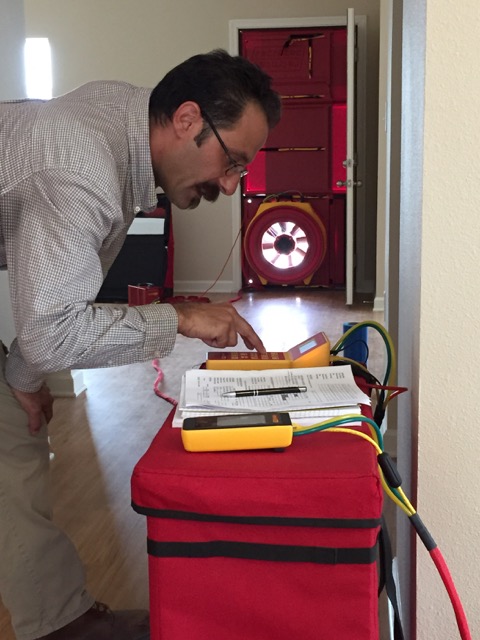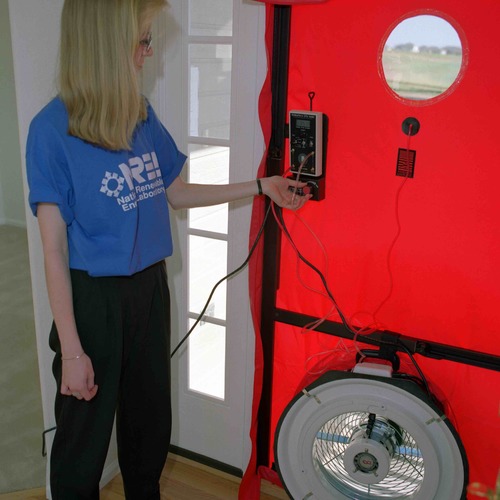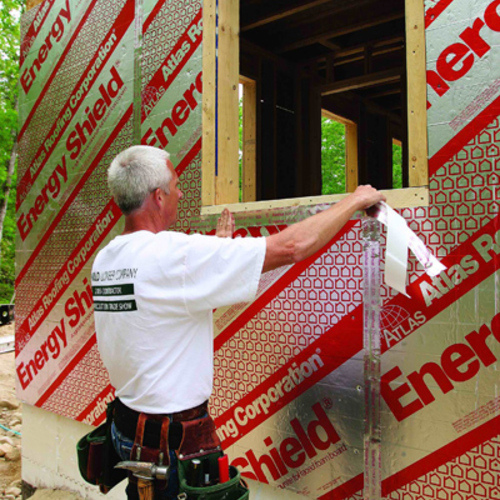
Image Credit: Energy Vanguard
Seven years ago, Georgia led the nation. Yep. We were the first state to adopt an energy code that made blower door testing mandatory. All new homes built in the state had to show through performance testing that they had an air leakage rate of less than 7 air changes per hour at 50 Pascals of pressure difference (ach50).
When I wrote about it in 2010, I called our new code “groundbreaking.” Since then, we’ve been passed many times by other states. Now we’re finally updating the energy code here, and it’s been a struggle to move that threshold from 7 ach50 to something lower. And the reason has nothing to do with the difficulty of air sealing.
Quick overview of the I-codes in Georgia
In 2010, Georgia adopted the 2009 International Energy Conservation Code (IECC) with amendments and supplements. The 2009 IECC didn’t actually have blower door testing as a mandatory requirement. That was a Georgia thing. At that time, the state also started requiring duct leakage testing and R-5 insulation for attic hatches. And we banned powered attic ventilators (except solar) and electric resistance heat used as a primary heat source.
In 2014, Georgia adopted the 2012 International Residential Code (IRC). One requirement in the mechanical section is that mechanical ventilation be installed if a house comes in more airtight than 5 ach50.
Now, in 2017, the Georgia Department of Community Affairs has been holding meetings to update to the 2015 IECC. We usually do every other code cycle, so we skipped over the 2012 version. The air leakage requirements in the 2015 IECC are in section R402.4.1.2 and stated thus:
The building or dwelling unit shall be tested and verified as having an air leakage rate not exceeding five air changes per hour in Climate Zones 1 and 2, and three air changes per hour in Climate Zones 3 through 8.
In the 2015 version, testing is now mandatory. That’s not a problem for us since we’ve been doing it since 2011 anyway. That doesn’t mean this update is easy.
The pain of an incremental improvement in airtightness
Since 2011, thousands of new homes in Georgia have passed a blower door test. One of the interesting things I observed early on was that home builders who had never had a blower door test done found it was pretty easy to hit 7 ach50. In fact, a lot of times they were coming in at 4 or 5 ach50.
The proposals to update to 3 ach50 in the northern part of the state (Climate Zones 3 and 4) and 5 ach50 in south Georgia (climate zone 2) shouldn’t be too hard, right? Builders can certainly get to 5 ach50 without a problem. Hitting 3 ach50 will be a bit of a stretch but is definitely doable.
Before long, however, it became clear in our meetings that we weren’t going to get below 5 ach50. Three ach50 was out, but it looked like we were on track for 5 ach50 until one of the big stakeholders pushed for no change at all in the threshold. That’s right. They wanted to stay at 7 ach50. But they might be willing to consider 6 ACH50, they said.
At the last subcommittee meeting, we seem to have made a little progress. The current proposal is to go to 6 ach50 for a year and then drop to 5 ach50. Yes, we have Climate Zone 2 in the south and 3 and 4 in the north, but we’re going to simplify to one threshold for the whole state.
I’m OK with this proposal — as long as we actually do get to 5 ach50 in a year. If that transitional year is used as a stalling tactic and we never get to 5 ach50, that’s not good. A house that tests at 7 ach50 is better than one at 10 or 15 ach50, which is probably where we were before 2011 when we didn’t test, but it’s still pretty leaky. At 5 ach50 max, we’d be doing pretty well, and not just because of airtightness.
The ventilation problem
You may have realized the problem when I wrote about Georgia adopting the 2012 IRC. In that code, a builder has to put in a mechanical ventilation system if the house tests out at 5 ach50 or less. So currently in Georgia, a lot of builders are aiming for the sweet spot — between 5 and 7 ach50. They want to pass the blower door test but not have to put in mechanical ventilation.
Not all builders are doing this, of course. Some will prepare for a ventilation system, stubbing in the essential components and then hooking it up if necessary. Builders who focus on high-performance homes install mechanical ventilation in all their homes.
Still, the sticking point in our code hearings this year is ventilation. If all homes have to have it because we require 5 ach50, builders have to pay for it and inspectors have to inspect it. What they’re saying is the state’s not ready for this because of a lack of knowledge about installing ventilation systems.
At the moment it looks like we’re going to get there, but the full committee still has to vote to approve it. The problem with not going all the way to 5 ach50 is that having that “sweet spot” between 5 and 7 or between 6 and 7 does a couple of things. First, it means that some builders will probably cheat. Yes, I’ve heard the stories of photocopied certificates and homes that all have the same test result. It does happen.
Second, it means we’re not seeing the truth about airtightness. Reducing air leakage is a good thing. Wait, no. Reducing air leakage is a great thing! It’s the single most cost-effective measure you can take to make a house more energy efficient, more comfortable, more durable, and more healthful. But it has to be paired with mechanical, whole-house ventilation. We want to seal up the random leaks and then get outdoor air into the house in an intentional way.
Come on, Georgia. We got this.
Allison Bailes of Decatur, Georgia, is a speaker, writer, building science consultant, and the author of the Energy Vanguard Blog. You can follow him on Twitter at @EnergyVanguard.
Weekly Newsletter
Get building science and energy efficiency advice, plus special offers, in your inbox.















3 Comments
north vs. south
I would think that the value of air sealing would not be all that different throughout the state, particularly if regions with milder winters have hotter, more humid summers. Is there something about the climate I'm missing? Now a moot point since the standard is moving toward being uniform, but I'm curious.
The energy use at any ACH/50 varies with climate . @ Charlie
The energy use per cooling degree-day is generally lower than the energy use per heating degree-day. The simple explanation for this is the higher COP efficiency of heat pumps at lower peak indoor to outdoor temperature differences in the cooling season than is seen in the heating season. eg:
The 1% outside design temp in Savannah (Zone 2, on the edge of zone 3) is 93F, which 15F above a 78F indoor design temp.
The 99% outside design temp is 29F, a 41F difference from a 70F indoor design temp.
All else being equal, pumping heat across a 15F difference takes less energy input per unit of heat moved than pumping it across a 41F difference. Put another way, efficiency rises as the temperature difference shrinks.
So even though there are more total CDD than HDD in that location, the average operating efficiency of the equipment is higher during the cooling season than in the heating season, and there is more energy used during the heating season. The average COP of a typical minimum-legal efficiency heat pump during the cooling season will be ~3.5 (=SEER 14), whereas the average COP during the heating season would need to hit an as-used HSPF of 12. That is impossible to get out of minimum-legal efficiency equipment (= HSPF 8.2), and requires at least some sizing optimization to get there even with modulating ductless mini-splits.
Stack effect pressures driving 24/7 infiltration are also higher at the larger heating season delta-Ts than the lower cooling season delta-Ts. That results in both higher air volume infiltration, but also higher BTU content per unit volume.
The higher infiltration, higher BTU content, and the lower heat pump efficiency at the larger seasonal delta-Ts make it rational to specify a tighter ACH/50 leakage in zone 4 than in zone 2.
Thanks Dana
Thanks Dana. That makes sense. In particular, I had missed the point that stack effect is reduced with the lower delta T, making infiltration weaker.
The flip side is that infiltration drives latent load more than other heat gains do. So the HVAC system input energy needed at a given delta T, given COP and given CFM of air leakage would be higher in the summer. But with a lower delta T, lower infiltration, and higher COP, the summer energy is lower despite the latent load.
Log in or create an account to post a comment.
Sign up Log in